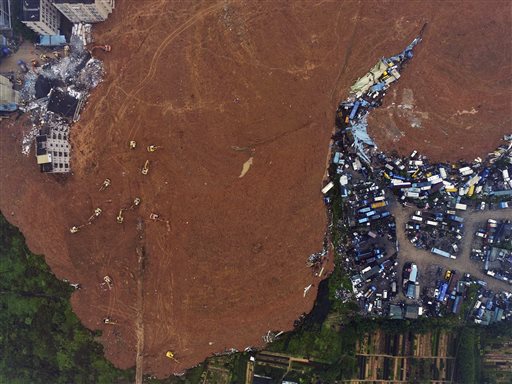UPDATE: 91 missing from landslide that buries buildings in China

In this photo taken from a drone mounted camera, rescue workers search for survivors in the aftermath of a landslide in Shenzhen in southern China’s Guangdong province Monday, Dec. 21, 2015. The massive landslide buried dozens of buildings when it swept through an industrial park in the southern Chinese city of Shenzhen. Color China Photo via AP
SHENZHEN, China — Rescuers were searching Monday for at least 91 missing people a day after a mountain of excavated soil and construction waste buried dozens of buildings when it swept through an industrial park in the southern Chinese city of Shenzhen.
China’s official Xinhua News Agency said the landslide buried or damaged 33 buildings in the industrial park in Shenzhen, a major manufacturing center in Guangdong province across the border from Hong Kong that makes products used around the world ranging from cellphones to cars.
Aerial photos on the microblog of the Public Security Ministry’s Firefighting Bureau showed the area awash in a sea of red mud, with several buildings either knocked on their side or collapsed entirely.
Posts on the microblog said mud had thoroughly infused many of the buildings, leaving the “room of survival extremely small.”
Just seven people were rescued overnight and 13 overall were hospitalized, including three with life-threatening injuries, according to state broadcaster China Central Television, or CCTV, which cited rescue leaders.
Article continues after this advertisementPersistent rain fell in the area on Monday, although it wasn’t clear whether that was hampering rescue efforts.
Article continues after this advertisementCellphone camera video of the noontime Sunday disaster run by CCTV showed the massive wall of debris slamming into the buildings and sending up huge plumes of dust.
Details began to emerge about the cause of the landslide, which authorities said covered an area of 100,000 square meters (1 million square feet) with up to 6 meters (20 feet) of mud.
The Ministry of Land and Resources said the debris originated with a steep, man-made mountain of dirt, cement chunks and other construction waste that had been piled up against a 100-meter (330-foot) -high hill over the past two years.
Heavy rains in the region had saturated the soil, making it increasingly unstable and ultimately causing it to collapse with massive force.
“The pile was too big, the pile was too steep, leading to instability and collapse,” the ministry said, adding that the original, natural hill remained intact.
Some area residents blamed government negligence for the disaster.
“If the government had taken proper measures in the first place, we would not have had this problem,” said one of the residents, Chen Chengli. “We’ve been down this road before, it’s too crazy.”
Chen’s neighbor Yi Jimin refuted arguments that the landslide was an act of nature.
“Heavy rains and a collapse of a mountain are natural disasters, but this wasn’t a natural disaster, this was man-made,” Yi said.
A man who runs a store selling cigarettes and alcohol less than a kilometer (half-mile) from the site said locals had known that the pile of soil was dangerous and feared something bad would happen.
“We heard a sound like an explosion and then all we saw was smoke,” said the man, who gave only his surname, Dong. “We knew what had happened immediately.”
The Ministry of Land and Resources said it had dispatched additional personnel to help monitor the situation and guard against a second collapse.
The 33 damaged or collapsed buildings included 14 factories, two office buildings, one cafeteria, three dormitories and 13 sheds or workshops, Shenzhen Deputy Mayor Liu Qingsheng said at a news conference.
Nearly 3,000 people were involved in the rescue efforts, aided by 151 cranes, backhoes and other construction equipment, along with rescue dogs and specialized life-detecting equipment.
CCTV said President Xi Jinping and Premier Li Keqiang issued orders to make rescuing those trapped the top priority.
The initial landslide sparked an explosion in a section of a natural gas pipeline owned by PetroChina, the country’s top oil and gas producer. By Monday morning, the fire was extinguished and a temporary section of pipe was being laid.
Xinhua said that as of Monday morning, 59 men and 32 women were missing in the landslide. No deaths had been reported.
Ren Jiguang, the deputy chief of Shenzhen’s public security bureau, told CCTV that most people had been moved to safety before the landslide hit.
State media carried photos of what looked like at least one five-story building leaning over and partly crumpled in the industrial park, and a sea of brown soil covering a vast area around it.
The landslide is the fourth major disaster to strike China this year following a deadly New Year’s Day stampede in Shanghai, the capsizing of a cruise ship in the Yangtze River and a massive explosion at a chemicals warehouse in Tianjian on the coast near Beijing.
Human error has been suspected or confirmed in all three previous disasters, pointing to an often callous attitude toward safety in China despite the threat of harsh penalties.
Three decades of headlong economic growth have been catching up with China in terms of safety and damage to the environment. Many of the country’s major cities suffer from chronic air pollution. A four-day smog red alert continued in Beijing on Monday, forcing schools to close, factories to curtail production and half the city’s cars off the roads.